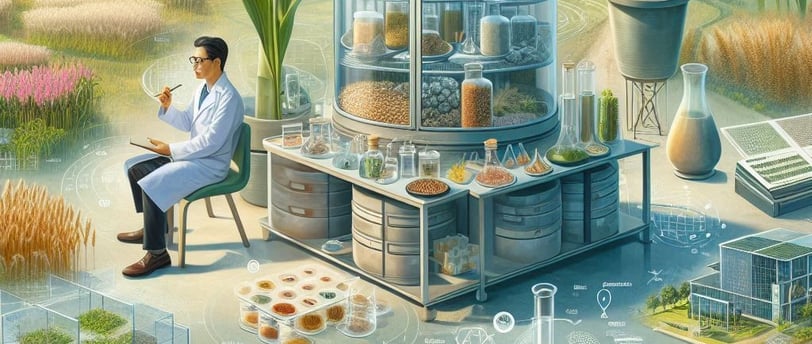Role of germplasm conservation in Agriculture its Strategies and challenges
Discover the significance of germplasm in agriculture! Learn how germplasm conservation is essential for plant breeding, research, and conservation. Explore the strategies, benefits, and challenges of preserving plant genetic resources and its role in sustainable agriculture. #germplasm #agriculture
AGRICULTURE
Nazma Khan PhD student Department of Agronomy, UAF. Dr Rizwan Maqbool Associate Professor, Department of Agronomy, UAF. Burhan khalid PhD student College of Plant Science and Technology, HZAU, China
8/5/20243 min read


Role of germplasm conservation in Agriculture its Strategies and challenges
Germplasm is genetic material used in plant and animal propagation. It is the raw material for plant breeding research and conservation; it underpins worldwide production of food, feed, fibre and fuel. In this post, I will discuss the role of germplasm conservation in agriculture, its approaches and challenges.
What is Germplasm?
Germplasm is the genetic material of plants and animals, preserved as seeds, tissue cultures, plants and animals. Access to germplasm is vital to obtaining valuable genetic sequence information about a species, a critical tool for plant biodiversity conservation. Germplasm is the raw material of agricultural production. Most of the valuable wild plant species that we use for food, medicine, fibre, landscaping and for other purposes would go extinct without it, and without access to it, no new plant species would ever be produced.
Role of Germplasm in Agriculture
Germplasm supplies agriculture with the raw genetic materials needed for:
Genetic Diversity: Germplasm is a store of the genetic variation within a species upon which breeding programmes that lead to the development of improved crop varieties depend. Genetic diversity underlies the resilience of agricultural systems, making it easier for crops to survive a variable and potentially harsh environment.
Germplasm stored in the Svalbard Global Seed Vault contains the genes that are used to create new cultivars of crops resistant to diseases, drought, flooding or higher productivity than existing varieties. In this sense, it is the germplasm held in the seed vault that is fundamental to meeting growing food demands of the growing world population.
Adaptation to Climate Change: Germplasm can be used to develop crop varieties that can adapt to altered weather patterns. As global temperatures rise, the ability to develop crops that can grow under these new conditions will be increasingly important.
Disease and Pest Resistance: Keeping a supply of existing traditional and wild germplasm varieties ensures crops with built-in pest and disease resistance, reducing the need for chemical pesticides to reduce crop loss and the environmental impact of farming.
Biotechnological uses: Germplasm serves as the raw material for many of the technologies of agricultural biotechnology, such as genetic engineering, enable sophisticated operations such as gene editing, and promise to improve performance and resilience of crops.
Strategies for Germplasm Conservation
Germplasm conservation involves two main approaches:
In-vivo Conservation: This involves maintaining living organisms, including:
In-situ conservation (on-site conservation): Preserving species in their natural habitats.
Ex-situ conservation (off-site conservation): preserving species outside their natural habitats, for example, in seed banks or botanic gardens.
In-vitro Conservation: Storing germplasm under laboratory conditions, including:
Cryopreservation: Freezing germplasm at very low temperatures to preserve it for long periods.
Slow-growth culture: Keeping plant tissues cultured so that they grow very slowly and survive for a long period of time.
Botanical gardens: Growing and maintaining living plants for conservation and research.
Pollen and DNA banks: Collecting and storing pollen and DNA samples for future breeding and research.
Farmer fields: Encouraging farmers to grow and maintain traditional crop varieties.
Genetic reserves: Establishing protected areas to conserve wild relatives of crops.
Benefits of Germplasm Conservation
Germplasm conservation offers numerous benefits, including:
Protection of germplasm, thereby protecting endangered plants – and preventing their extinction By maintaining germplasm, we protect endangered plants.
Assuring Genetic Diversity: having diverse genetic stocks is key to crop adaptability and resilience.
The development of Climate-Resilient Crops: Conservation of germplasm provides the means to develop crops that can withstand a changing climate.
Increased Yield and Quality: Better breeding programmes can use germplasm to develop crops that yield more, and have better nutritional quality.
3. Reduced need for chemical inputs in farming Disease-resistant and pest-resistant crops require less chemical pesticides and fertilisers – essential for sustainable farming.
Challenges in Germplasm Conservation
Despite its importance, germplasm conservation faces several challenges, including:
Accumulation of Duplicates: Managing and identifying duplicates in germplasm collections can be resource-intensive.
Decreased Genetic Diversity: excessive reliance on a few varieties of crop plants can lead to a more restricted genetic variety.
Buildup of Bad Alleles: Bad alleles accumulate in conserved germplasm, potentially compromising its health and fitness.
Low rate of recombination: Slow rates of recombination hamper the evolution of beneficial new combinations.
A negative implication of climate change is that this will make it harder to utilise in-situ conservation approaches that rely on the wild relatives of crops because the habitats of these wild relatives are also likely to be impacted by climate change.
Conclusion
Germplasm conservation is essential for ensuring food security in the world and for promoting sustainable agriculture. Increased knowledge in biotechnology and implementation of some of its innovations in germplasm conservation, storage and manipulation have helped in appreciable conservation of the plant genetic resources. If germplasm is collected, stored and handled properly, these advances can be utilised to better understand plant diversity and the management of the available genetic resources. It will be possible to overcome the crop-related challenges and enhance gene bank protocols, further taking advantage of cryopreservation techniques, to have a sustainable ‘knowledge bank’ for the selection of crops, which will be better suited to the environment, more resistant to pests and pathogens, and fortified with more nutrients.
